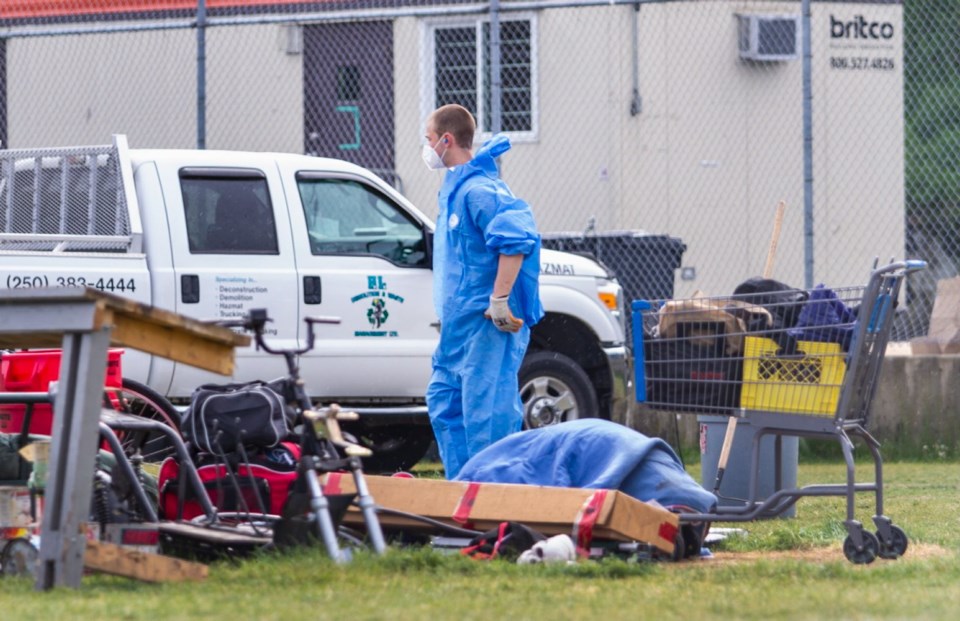On March 17, B.C. declared the COVID-19 epidemic a public health emergency, and not long after media and government played on repeat: “We are in this together.”
In the midst of a global health emergency, our greatest social injustices began to emerge. With alarming rates of infection and death among elderly communities, long-term care homes, amongst health-care providers and within radicalized communities, nations such as Canada were faced with the stark reality that we have not been in this together.
For persons experiencing homelessness, the more devastating message seems to be: “We are not all in this together, and we really don’t care.”
In the rush to lock down communities and shelter in place, people made vulnerable through poverty and homelessness were locked out of social and health-care services and were hurried into state-imposed tent cities such as Topaz Park.
Unlike informal tent cities, which develop from existing relationships among people experiencing homelessness, with an emphasis on community building and participation, Topaz was state-imposed and operated.
On April 25, these interests crystallized as a public safety order was introduced, announcing the eviction of tent cities such as Topaz. Alongside this order, indoor shelter and temporary housing in the form of hotel or motel rooms was announced, with a promise from Social Development Minister Shane Simpson that people in the camps would not be abandoned.
What followed, despite what might be promised or reported, was nothing short of horrific.
Alongside the public-safety order, fencing soon appeared at Topaz Park. Despite concerns from clinicians, outreach workers and peer staff about these physical barriers, B.C. Housing and the provincial government refused to change their approach, suggesting that the fencing was a tool for safety.
In reality, the fencing surrounding the main campsite and weaving throughout the park, separating one area from another, served as a harsh physical barrier that mirrors the spiritual and emotional barriers between people who are housed and those who are not.
It also prevented people working in the park from safely providing life-saving services, including overdose response. The presence of these fences was and will always be an egregious affront to the health and safety of all people in tent cities and is a devastating reminder of the colonial instruments used by government to cage, displace and harm “others.”
On April 24, social-services staff members in Topaz Park, and other similar shelter-in-place tent-cities, were given four hours to capture the names of all people who had moved into these spaces.
Shortly after, a crew of hazmat, bylaw and police officers started physically marking tents and tent spaces. These markings were meant to delineate between those individuals who had been sheltering at the park before April 25 and those who had arrived afterwards, even though they had been told by the government to go there in the first place.
The markings facilitated a process of demolition, wherein personal possessions including money, identification, pictures of family and survival tools like tents, sleeping bags and blankets were thrown out and destroyed.
Even individuals who had been sheltering at the park before April 25 had personal possessions and shelters removed and destroyed.
Months after the public-health emergency was declared, and after being told to shelter in Topaz Park to await housing options, the only shelter people had — tents — were destroyed.
Additionally, it has become clear that not everyone who needs housing will be able to access a safe place indoors, including people captured on the April 24 census. Despite the promise that “no one will be abandoned,” we know that many have and will be. But you can’t abandon someone you never intended to help in the first place.
Recently a news article proposed that post-pandemic, we not forget the homeless, suggesting that for a moment, we remembered or cared.
In reality, what we did was respond to our own discomfort and guilt. Topaz was an eyesore for Not In My Back Yard-ers; it reminded us that society and the systems upon which it is established are not developed for the greater good, but intentionally disenfranchise people who are made to endure high-risk conditions and then blamed campers and presumed guilt of any problems that arose.
In an effort to remedy our own discomfort, we neglected to really demonstrate that we could be in this together, because we never were. If our purpose was to end homelessness, there never would have been a public-safety order to evict three tent cities.
Yes, that resulted in more indoor spaces, and hopefully more permanent housing, but it also resulted in more trauma and people were left behind.
Lacey Alexandra Mesley has been working in harm reduction and outreach for nearly 10 years, and has been providing outreach support at Topaz Park from its inception.



